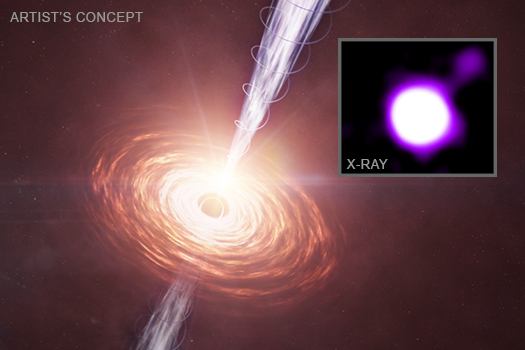Peering back in time, around 12 billion years, astronomers using the Atacama Large Millimeter/submillimeter Array (ALMA) have found the most distant and direct evidence of scorching gas in a forming galaxy cluster, SPT2349-56. The hot plasma, seen when the Universe was just 1.4 billion years old, is far hotter and more pressurized than current theories predicted for such an early system.
Recent News
Cosmic Lens Reveals Hyperactive Cradle of Future Galaxy Cluster
Astronomers using the U.S. National Science Foundation Very Large Array (NSF VLA) and the Atacama Large Millimeter/submillimeter Array (ALMA) have discovered a rare protocluster that was exceptionally bright, all when the Universe was 11 billion years younger. The system, called PJ0846+15 (J0846), is the first strongly lensed protocluster core discovered, revealing how some of the most massive galaxy clusters in the present-day Universe began their lives.
Stars That Die Off the Beaten Path
Astronomers have created a detailed forecast of where they expect to observe future stellar explosions in a nearby galaxy, opening a new window into how exploding stars shape the cosmos.
NASA’s Chandra and the Very Large Array See Surprisingly Strong Black Hole Jet at Cosmic “Noon”

Credit: X-ray: NASA/CXC/CfA/J. Maithil et al.; Illustration: NASA/CXC/SAO/M. Weiss; Image Processing: NASA/CXC/SAO/N. Wolk
A black hole has blasted out a surprisingly powerful jet in the distant universe, according to a new study from NASA’s Chandra X-ray Observatory. This jet exists early enough in the cosmos that it is being illuminated by the leftover glow from the big bang itself.
Astronomers used Chandra and the U.S. National Science Foundation Karl G. Jansky Very Large Array (NSF VLA) to study this black hole and its jet at a period they call “cosmic noon,” which occurred about three billion years after the universe began. During this time most galaxies and supermassive black holes were growing faster than at any other time during the history of the universe.
Scientists can use this jet to probe questions about how black holes helped shape their surroundings during this critical era in cosmic history. This science was presented at the 246th American Astronomical Society Conference in Anchorage, Alaska on Monday, June 9, 2025, 10:15 AM AK. You can read the full release from Chandra.
About NRAO
The National Radio Astronomy Observatory (NRAO) is a facility of the U.S. National Science Foundation, operated under cooperative agreement by Associated Universities, Inc.
This news article was originally published on the NRAO website on June 11, 2025.
Recent News
New Discovery Challenges Evolution of Galaxy Clusters
Peering back in time, around 12 billion years, astronomers using the Atacama Large Millimeter/submillimeter Array (ALMA) have found the most distant and direct evidence of scorching gas in a forming galaxy cluster, SPT2349-56. The hot plasma, seen when the Universe was just 1.4 billion years old, is far hotter and more pressurized than current theories predicted for such an early system.
Cosmic Lens Reveals Hyperactive Cradle of Future Galaxy Cluster
Astronomers using the U.S. National Science Foundation Very Large Array (NSF VLA) and the Atacama Large Millimeter/submillimeter Array (ALMA) have discovered a rare protocluster that was exceptionally bright, all when the Universe was 11 billion years younger. The system, called PJ0846+15 (J0846), is the first strongly lensed protocluster core discovered, revealing how some of the most massive galaxy clusters in the present-day Universe began their lives.
Stars That Die Off the Beaten Path
Astronomers have created a detailed forecast of where they expect to observe future stellar explosions in a nearby galaxy, opening a new window into how exploding stars shape the cosmos.
